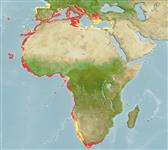Classification / Names
Common names from other countries
Main reference
Size / Weight / Age
Max length : 63.0 cm TL male/unsexed; (Ref. 39256); 59.7 cm TL (female); common length : 35.0 cm TL male/unsexed; (Ref. 2683)
Length at first maturity
Lm ?, range 44 - ? cm
Environment
Marine; brackish; demersal; depth range 17 - 462 m (Ref. 56504), usually 50 - 150 m (Ref. 27121)
Climate / Range
Subtropical, preferred ?; 44°N - 35°S
Distribution
Eastern Atlantic: northern Portugal and throughout the Mediterranean to Madeira and South Africa. Reported from the Canary Islands (Ref. 3167) but occurrence needs verification (Ref. 6808). Also in southwestern part of the Indian Ocean.
Countries | FAO areas | Ecosystems | Occurrences | Introductions
Short description
Dorsal
spines
(total): 0;
Anal
spines: 0;
Anal
soft rays: 0. Snout short and bluntly pointed; disc angular (Ref. 5578). Upper surface prickly only in young, nearly smooth in adults, underside smooth (Ref. 3167). Upper surface ochre to reddish-brown with scattered dark spots, underside white (Ref. 3167); two bright blue eyespots centered on the pectoral bases (Ref. 5578); may have a small dark spot on tip of snout (Ref. 2708).
IUCN Red List Status (Ref. 115185)
Threat to humans
Harmless
Human uses
Fisheries: commercial; gamefish: yes
More information
ReferencesAquacultureAquaculture profileStrainsGeneticsAllele frequenciesHeritabilityDiseasesProcessingMass conversion
Tools
Special reports
Download XML
Internet sources
Estimates of some properties based on models
Phylogenetic diversity index
PD50 = 0.5000 many relatives (e.g. carps) 0.5 - 2.0 few relatives (e.g. lungfishes)
Trophic Level
3.7 ±0.6 se; Based on diet studies.
Resilience
Low, minimum population doubling time 4.5 - 14 years (Fec assumed to be <100)
Vulnerability
Moderate to high vulnerability (51 of 100)
Price category
